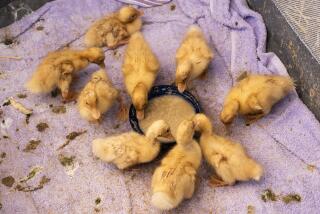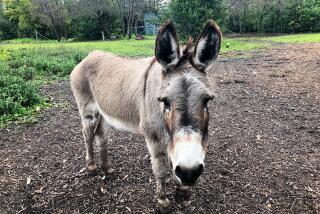Rescuers Help Ease Burros’ Burden
- Share via
In the two years that Mark and Amy Meyers have run the Peaceful Valley Donkey Rescue at their modest Acton ranch, they’ve had to put up with every manner of jackass joke.
Their relatives think they’ve lost it, and on some nights their kids can’t sleep for the braying. Their yard smells, to put it delicately, of donkeys.
The family is aware its rescue operation isn’t the most glamorous one in the rolling hills of Acton; a few miles away, actress Tippi Hedren keeps neglected African elephants and snow leopards at her Shambala Preserve. But the Meyerses stay stubbornly focused on what they believe is a serious problem: the neglect and abuse of the domesticated burro.
“We’ve had them with broken noses, broken teeth--we have one right now, one nostril is almost completely removed, from whatever happened to him,” said Amy, 27, as she trudged across the corral in her side yard, dragging a feed bag from beast to beast. “We have a couple we got from Tahoe who never bray. Every time they did, [their former owners] would throw a rock at them.”
The couple have taken in more than 40 donkeys from across California, and have placed about 20 with adoptive families, who pay a $400 fee. The Meyerses buy the animals for next to nothing at swap meets and auctions, or pick them up from homes where they have been neglected or physically abused.
“And I’ll tell you, we never run out of people who abuse them,” Mark Meyers said.
Donkeys’ Plight Getting Worse
Once a common beast of burden in rural America, the donkey has become something of a living relic. While the obstinate creature has always suffered at the hands of humans, the Meyerses believe its plight is getting worse. The art of working with and caring for the animals is vanishing, they say, as the number of real ranches shrinks and more donkeys end up at suburban ranchettes. Rough estimates place the U.S. donkey population at 250,000.
“It’s not the old days where you relied on your animals for your living,” Amy Meyers said. “But there’s a lot of impulsive people who say, ‘Let’s just fill up our corral.’ Then maybe they find a new hobby, or get too busy at work.”
Some owners are unaware a donkey can’t be motivated the same way as a horse, her husband said. “You can literally beat them to death and they won’t move if they’re not ready.”
But neglect is more common, the Meyerses say: Donkeys demand the same care as a horse, but they’re not a major investment, and people often fail to shave the animals’ hooves, feed them regularly, and call the veterinarian for checkups.
“People forget about them,” Mark said. “Unlike a dog, they can’t come in the house.”
Amy, who grew up around horses, bought her first burro, Izzy, about two years ago as a companion to an aging gelding. She and her husband launched the rescue operation soon after.
Mark, an electrical contractor, has scaled back his work schedule in part to devote more time to the project, which received its nonprofit status in January. A burly man who admits he prefers animals to most people, Mark Meyers has become something of a public figure around these parts, running ads about the donkeys in the north county newspapers and educating people with appearances in local parades, as well as through the rescue Web site: https://www.donkeyrescue.org.
The family’s five-acre spread is at the end of Peaceful Valley Road, in a pocket of dusty ranchland a few miles south of Palmdale. The air takes on the tang of animal flesh on the approach to the Meyerses’ small, sky-blue ranch house. Their 25 donkeys share the property with five dogs, a cat, a bird, six goats, two horses and five children, who help with the feeding.
The neighbors are just far enough off to tolerate the donkeys’ hee-haws, moans and foghorn honks.
Like proud parents, Mark and Amy Meyers can rattle off the names of each of their long-eared charges--the scruffy and the elegant, the sweet and the ornery, even the potentially dangerous.
“Some of them, you get in the pen with, they’ll try to kill you,” Mark said, approaching a sick black male named Elliot with a syringe full of antibiotics. “A horse’s first instinct is to flee, but a donkey’s first instinct is to fight. That’s why a lot of [ranchers] keep them around as protection from coyotes.”
Burros Suffer From Neglect, Mistreatment
Mark said another male in his care was typical of the more serious cases. Job, a dark brown 18-year-old from Lucerne Valley, was being “starved to death” by an increasingly forgetful man in his 90s, Mark said. Tiger, an 8-year-old female, was rescued from Doyle, Calif., after a man reported that the owner was throwing rocks at it. Rawhide, bought from a horse trader, has scars on his legs; cowboys had used the animal for roping practice--one of the more common abuses.
“People will say to us, ‘We take good care of our roping donkeys,’ ” Amy said. “Well, you feed ‘em and stuff, but that doesn’t mean you’re doing right by ‘em.”
Acton resident Nancy Crosby, 52, read about the Meyerses in a local paper and decided to adopt a donkey as a pet for her 14-year-old daughter. One-year-old Romeo, she said, has been a great companion--sweet, smart and fond of animal crackers--and Crosby plans to adopt another one. But she said it’s hard to escape the feeling that history has left these animals behind.
“What use is a donkey?” Cosby said. “You can’t ride it like a horse or work it like you can a mule, so what good are they, unless you get it as a pet like we did?”
U.S. Agency Runs Adoption Service
In Western ranching circles, the U.S. Bureau of Land Management runs the best-known burro adoption service. It places thousands of wild donkeys and horses with private parties to control their populations on federal lands.
The American Donkey & Mule Society, a nonprofit based in Denton, Texas, estimates the U.S. burro population at 250,000, and says there are only a handful of domestic adoption services, and that more are needed. Part of the problem, society co-founder Betsy Hutchins says, is that donkeys are often an impulse buy and can live 40 years.
“They can outlive several owners,” she said. “They buy the animals for pets, and maybe even enjoy them, but they don’t know how to take care of them. . . .” They’re city folks--you know, most of these people shouldn’t even have a dog.”
Though the rescue project solicits donations and uses volunteers, the Meyerses say they put about $2,000 of their own money a month into the operation. And while the rescue takes a bite out of the family budget, they’re planning to stick with it, despite the occasional ribbing from the locals.
“The first question is, ‘Why donkeys?’ ” Mark said. “We realized we had to do something. The next thing you knew we had more donkeys than you could shake a stick at.”
More to Read
Sign up for Essential California
The most important California stories and recommendations in your inbox every morning.
You may occasionally receive promotional content from the Los Angeles Times.










